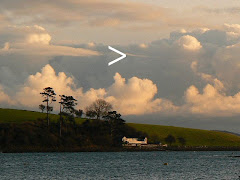Note: this post edited as follows on 16th June:-
Thanks to GTC and others for the information provided in comments to this post (and by email), that it was not one of the Quandelacys from Zuni, but Salvador Romero from Cochiti Pueblo, northwest of Albuquerque, who carved our wolves. Apologies to Salvador Romero.
Getting on for twenty years ago, at a pre-Christmas 'meet the neighbours' gathering near our former home in rural central Scotland, Lynn got in conversation, and felt an instant affinity, with a girl whose mid-Atlantic accent and decidedly Southwestern (as in southwestern USA) outfit made her stand out from the crowd. She was wearing a long denim skirt over a pair of tan cowboy boots; a denim top cinched at the waist with a silvered leather belt - and a necklace strung with perhaps a dozen little horses, carved in turquoise. Leslie will no doubt correct me if I have got the details wrong, but she won't deny that her quintessentially Western outfit was bound, in that company, to be a stand-out.
Leslie and Andrew became, and remain, our great friends and incidentally cemented a growing fascination with the Desert Southwest and in particular the art and culture of New Mexico, America's 47th state - 'Land of Enchantment'.
At that first encounter Lynn remarked on the turquoise necklace; and to cut a long story short, carved and decorated Zuni fetishes from a dealership called Keshi on Don Gaspar in Santa Fe, have become something of a staple for friends' weddings, special birthdays and anniversaries - most notably our own tenth, when we bought ourselves a pair of stone wolves, above, carved (I think - Leslie will keep me right) by a member of the renowned Quandelacy family of Zuni Pueblo in northwestern New Mexico.
Keshi was formed as a cooperative in the 1980s and sources all its products direct from the pueblo - a kind of New Mexican Fair Trade arrangement which guarantees authenticity, quality and most important, a reliable route to market for the artisans of the pueblo.
Fetishes are as old as the Zuni religion, and generally represent the spirit of the animal which is the subject of the carving: originally, following a successful hunt an arrowhead might have been placed on a stone with the general appearance of the hunted animal, along with a prayer of gratitude for the animal having given its life for the sustenance of the hunter and his family. The principal was extended to many different animals, each associated with one of the Six Sacred Directions (East, West, North, South, Above, Below), their likenesses in stone being imbued with qualities particular to those animals, like swiftness (horse) or strength (bear).
Our wolves are bound together with sinew and decorated with pieces of turquoise, and they stand on a driftwood shelf on the wall of the cabin living room, looking out over Ringhaddy Sound. A long way, you might think, from the high desert of northern New Mexico; but then the wolf represents friendship, loyalty and family, and these are qualities that surely travel well.
.jpg)















